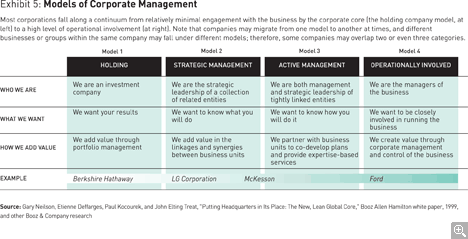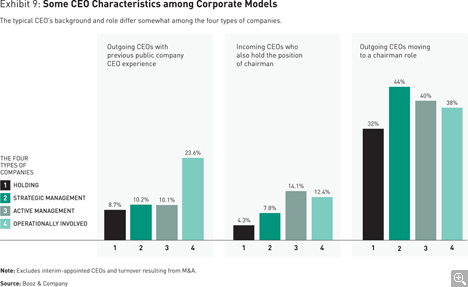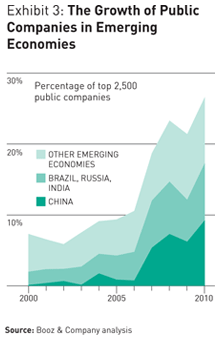CEO Succession 2010: The Four Types of CEOs
Booz & Company’s annual study of turnover among chief executives — now increasingly diverse, as the world’s largest companies migrate to emerging economies — suggests that the nature of the job varies with the role of the corporate core.
Every year, Booz & Company takes a long and penetrating look at CEO succession among the world’s top 2,500 public companies. Our research now goes back consecutively to 2000, giving us 11 years of perspective on the tenure and position of these global business leaders. Each year we consider a new dimension in our study of CEO succession. This year, we looked at the role of the CEO and its effect on tenure and turnover. How hands-on are the CEO and his or her senior team? How do they engage themselves with the businesses they lead? We found that these factors have a noticeable effect. The more involved headquarters is in operational decision making in any given company, the more tenuous the CEO’s tenure is likely to be.
We also found several noteworthy trends this year. There is a steep decline in CEO turnover worldwide: A higher proportion of chief executives are staying in office than we saw in 2009. (See Exhibit 1.) That doesn’t mean that governance is growing more relaxed; the rates of CEO turnover are still much higher in general than they were in the 1990s, and the pressure on performance remains as great as ever. But it does suggest that some basic trends in CEO hiring and oversight have solidified as standard practice. Last year, we referred to the 2000s as a “decade of convergence and compression,” and this pattern continued in 2010. Around the world, for example, fewer CEOs are also board chairmen this year than was the case the year before, and more CEOs are being appointed from inside companies, rather than from outside.
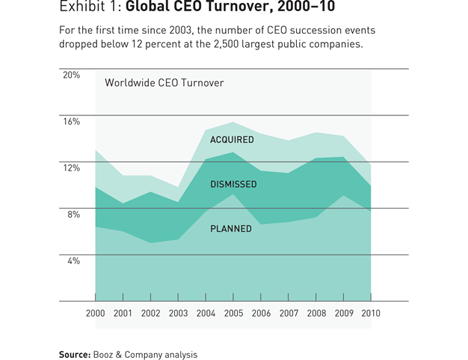
In one respect, however, the largest public companies are becoming more diverse: They are increasingly based in emerging economies, rather than in the mature economies of the United States, Canada, western Europe, and Japan. For years, in compiling our list of the 2,500 largest publicly held companies in the world (as ranked by their market capitalization), we have observed this gradual migration. (See Exhibit 2.) To explore the implications more closely this year, we divided our study sample over the past 11 years into mature and emerging economies (based on the United Nations’ Human Development Index for 2010), and then further broke out the BRIC countries (Brazil, Russia, India, and China). We found that the share of companies from emerging markets in our sample has grown at a compound annual growth rate of 14 percent over the past 11 years; BRIC representation has shot up 24 percent annually. China, in particular, shows staggering growth, accounting for one in five new entries in our sample this year (83 of the 415 new members of the world’s 2,500 largest companies).
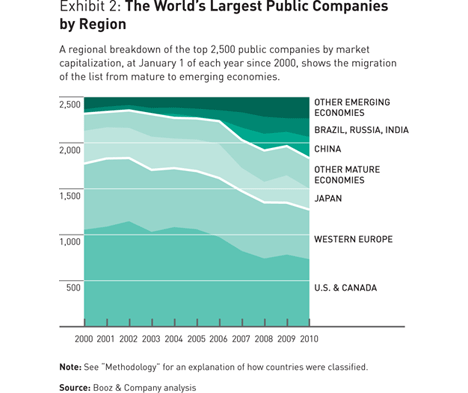
For those who see North America and western Europe as the commercial centers of the world, the news is even more striking; for the first time, almost half the companies on the list are located outside those two regions. In fact, the number of the top 2,500 companies based in the U.S., Canada, and western Europe has fallen some 28 percent altogether since 2000.
Finally, a significant milestone was reached in 2010: More than one-quarter of the top 2,500 public companies now have their headquarters in emerging economies. Could this suggest that global enterprise is nearing a geographic tipping point? Within a few years, if this pattern continues, the companies in the world’s mature Western economies could represent a minority of our sample. Already, the Asian economies (China, Japan, rest of Asia) are the new center of gravity in terms of global market heft, with 895 companies in this year’s sample versus North America’s 772 companies and Europe’s 619 companies.
Global Turnover in 2010
This shift in the mix of companies in our global sample is already influencing CEO succession trends, as companies with new governance structures and different growth arcs come to the fore. (See “A Tipping Point for the Global Economy,” by Ivan de Souza and Edward Tse, below.)
For example, one can surmise that the growing presence of Chinese companies in our sample helped bring down the global rate of CEO turnover this year. Because of their high degree of government ownership, China’s biggest companies manifest extremely low CEO turnover — half the global average. In 2010, CEO succession worldwide hit a six-year low of 11.6 percent; Chinese companies’ turnover was only 5.2 percent.
However, the overall drop in turnover in 2010 is not solely China’s doing; in general, there was a sharp reduction in both forced and planned turnover at the top. There are several possible reasons for this. First, the global recession’s lingering effects influenced companies to keep a steady, seasoned hand at the helm. Second, boards have gotten better at selecting CEOs and ensuring their smooth succession. Finally, given the historically high rates of forced turnover in the last few years, there were fewer companies that hadn’t made a recent change in chief executives.
Global Governance Trends
We broke down the data to assess what it means for today’s boards as well as for sitting and aspiring CEOs. Many long-term trends in governance still hold. Boards around the world increasingly separate the roles of chairman and CEO, especially in North America, where only 14 percent of incoming CEOs were assigned both titles in 2010 (versus 52 percent in 2001). Related to this trend is the practice of appointing an outgoing CEO as board chairman, to apprentice the incoming CEO. We continue to see this model growing in prevalence — except in Japan, where it has long been the norm (it accounts for more than two-thirds of successions there).
Another Japanese tradition, appointing insiders, is also becoming a worldwide phenomenon. Among the 291 succession events we assessed in 2010, insiders ascended to the CEO spot 81 percent of the time. Insiders also last longer — in 2010, those insiders leaving office had lasted on average 7.1 years, versus 4.3 years for outsiders. This is not surprising; insiders have historically produced superior returns for their shareholders. Last year was no exception. Insider CEOs leaving office generated total shareholder returns on a regionally adjusted basis of 4.6 percent as compared with 0.1 percent among outsiders.
On average, compared with 10 years ago, CEOs are being appointed at a later age. The average appointment age among outgoing CEOs in 2010 was 52.2, versus 50.2 in 2000. This suggests that boards continue to value experience in selecting a CEO. In tracking outgoing CEOs, we found that the percentage of chief executives who had previously served as CEOs of a public company has risen markedly over the past 11 years, from 4.3 percent in 2000 to 15.2 percent in 2010. And in 2010’s incoming class, more than half (51 percent) of new outsider CEOs came from within the same industry — suggesting that boards are getting more particular about the type of candidates they are seeking.
CEOs are also staying in office for less time, compared with 11 years ago. For outgoing CEOs, the mean tenure was 18 months shorter: 6.6 years in 2010 versus 8.1 in 2000. In particular, the length of planned tenures — in which the CEO departs on a date that has been prearranged with the board — has dropped by 30 percent over the last 11 years, from 10 to seven years. These findings suggest that CEOs are finding the demands of the job more pressing than their predecessors did.
Four Models of Management
This year we applied an additional lens to our study of CEO succession events at the world’s largest companies by examining the impact of the corporate core. The corporate core is made up of the CEO, his or her senior team, and a defined set of support functions necessary for the entire corporation. Back when the senior management team of a typical large company could all have offices in one location, this was known as headquarters. All corporate cores provide leadership, create the context for growth, represent the corporation to the public and investment community, and provide essential services to the business units, which are consigned maximum responsibility for money-making activities. That’s where the similarities among companies end. As any CEO can tell you, each corporate core is a unique blend of skills, responsibilities, and personal management styles tailored to the nature of the businesses it oversees and the competitive environment in which it operates. On the basis of our in-depth experience with hundreds of corporations at Booz & Company, we have found that they fall along a spectrum of four different corporate models — defined by the way senior management and the corporate core engage with the rest of the business. (See Exhibit 5.)
The first model, at one extreme, is the highly diversified holding company — distinguished by its arm’s-length approach to managing its subsidiary operations. Holding companies add value through strong portfolio management. The second model is the strategic management company, which offers guidance and leadership on strategic direction and provides expectations of performance for its group of related businesses. The third model involves more active management. These corporate cores oversee more tightly linked businesses and advise on operational issues. The fourth corporate model is the highly operationally involved company, in which senior management plays an active role in day-to-day business decision making.
To briefly sum up each model from the point of view of a business unit leader: Holding companies want your results. Strategic management headquarters want to know what you will do. Active management corporate cores want to know how you will do it. And operationally involved executive teams want to work closely with you in running the business.
As part of our research on CEO succession and related issues, we have interviewed chief executives working within these models. Their experience sheds light on the operation of these models, the patterns of CEO succession that seem to follow the models, and the implications for business leaders.
Holding companies (Model 1) manage their businesses much as a financial fund manager oversees a portfolio of investments. The CEOs of this first group of companies have a minimal degree of involvement in operational decisions. They are primarily interested in results, not in how the results are generated. The corporate core establishes and ensures managerial and financial discipline. Holding company chief executives are a level removed — they focus on portfolio management while the second-tier executives run the businesses. If there is a problem, more often than not, its fallout is felt at that second management tier.
Warren Buffett, CEO of Berkshire Hathaway Inc., typifies this type of management. As he noted in his letter to shareholders in the 2010 annual report, “At Berkshire, managers can focus on running their businesses: They are not subjected to meetings at headquarters nor financing worries nor Wall Street harassment. They simply get a letter from me every two years…and call me when they wish. And their wishes do differ. There are managers to whom I have not talked in the last year, while there is one with whom I talk almost daily. Our trust is in people rather than process. A ‘hire well, manage little’ code suits both them and me.”
Strategic management companies (Model 2) exercise a bit more oversight in managing their operations. The corporate core offers strategic guidance to its local businesses, but not the supervision of operational decision making. A good example is the Korea-based LG Corporation, a US$104 billion company originally known for its brand name Goldstar. (LG once stood for Lucky Goldstar.) At first glance, because of its global operations spanning consumer electronics, mobile communications, home appliances, chemicals, and more, LG might seem to fit the definition of a diversified holding company such as Berkshire Hathaway. But Juno Cho, president and CEO of LG Corporation, notes that the company’s corporate core has always operated more in a strategic management model.
Cho describes his role, and that of other senior management, as closely engaged in strategic goal development with executives of subsidiaries such as LG Chemical and LG Electronics, where central core team members often sit on the boards. “We effectively agree on strategic goals and targets with the businesses and give them accountability,” says Cho. Once each year the group chairman of LG Corporation conducts a consensus meeting with the presidents of all the business units to discuss, understand, and agree on their annual business plan. “This is the backbone of our communication,” says Cho. “Corporate executives chair the board of each business unit, so we have a real-time understanding of performance, but it would be impractical to get deeply involved in operational matters. Since LG is such a big organization, the corporate core limits its voice to brand-building, R&D expenditures, high-level human resources decisions, and capital investment.”
Active management companies (Model 3) have a corporate core that starts to share accountability with the business units for major operational decisions and adds value through close guidance and expertise. John H. Hammergren, chairman, president, and CEO of the McKesson Corporation, a leading pharmaceutical distributor and healthcare IT company based in North America, describes his corporate core as moving back and forth between the strategic and active management models.
“We want our businesses to drive the McKesson culture,” says Hammergren, “but the corporate executive team also wants to guide the businesses on how they do it. We follow a similar approach when it comes to leadership development — whereas with sales training, we expect the businesses to take the lead, because sales training is more specific to their business.”
Hammergren says that the corporate officer group at McKesson performs several key roles. “First, it sets the culture: the tone at the top — for example, what standards we are going to hold for ourselves, both at the executive committee level and in our interactions with the leaders of the business units. Second, corporate upholds a set of principles that ensure all of our business units put the customer at the center of everything we do. Third, we manage the cadence of the management team: in other words, how we plan our strategy; how we conduct our operating reviews; what we expect of the business units; and what processes, like Six Sigma and the corporate calendar, we use to drive results.” The top group also establishes the rules of engagement between the corporate core and the business units, determining when businesses should expect that headquarters will be involved, and when they can assume the authority and decision-making power to move forward on their own.
“We manage the corporation through two key management teams,” says Hammergren. “The first is the executive committee, comprising my direct reports; the second is an operating team that consists of the presidents of the major businesses. I inspect each major business at least quarterly, and I’m actively involved in the budget-setting process and leadership decisions at the business unit level. The executive committee meets every other week to take up performance within the various businesses, large M&A transactions, Wall Street expectations, deployment of capital, leadership development, succession planning, balance sheet management, board reporting, overall corporate strategy, and those kinds of issues.”
Hammergren notes that it would be extremely difficult to move McKesson to a model of full operational involvement. “Given the complexity of our company, it would be impossible for the CEO to call the orders every day on the execution side. I wouldn’t be close enough to the fight to know which way to send the troops; and the people who run these businesses would get disenchanted and disheartened, because I would probably not do their jobs as well as they do them.”
Operationally involved companies (Model 4) are enterprises in which the corporate core is involved in management more directly. This does not mean that the CEO and top team are involved in every aspect of day-to-day management; execution remains the business units’ domain. Rather, the corporate core adds value through the development of cross-company capabilities and functional expertise, and gets involved in strategic decision making for most or all business units. Because of the highly engaged nature of the corporate core in managing the business, these companies are typically focused within a single industry.
Ford Motor Company under CEO Alan Mulally is a good example of an operationally involved corporate core. According to an Economist article published December 9, 2010, Mulally began to convene weekly meetings of his senior team soon after he arrived in September 2006. He pushed the attendees to bring up operational problems and collaborate in solving them. When the head of Ford’s operations in the Americas admitted that his group had a serious problem with defective parts, instead of falling from grace, he was applauded by Mulally, who exclaimed, “Great visibility.”
To maintain a tighter rein on the carmaker’s fundamental business, Mulally and his key lieutenants decided to concentrate on the Ford brand and divest the Premier Automotive Group — a collection of high-end brands that had been acquired under previous regimes. The company quickly sold Aston Martin, Jaguar, Land Rover, and Volvo. Ford also decided to produce a much narrower range of cars built on a few core platforms, focusing on quality and flexibility. At one point, Ford produced nearly 100 different models around the world; now it is down to a third of that number and may go lower. For clarifying and simplifying the management challenges at Ford, “you cannot believe the difference this makes,” noted Mulally.
The Most Challenging Corporate Model
As part of this year’s study, we identified which of the four corporate core models applied most closely to each of the 291 companies that experienced a succession event in 2010. We based our analysis on such factors as the number and diversity of business units, the degree of activity sharing among those units, and the number and proportion of senior line and staff managers. We also called on our own firm’s industry expertise and our direct experience with many of these companies. The breakdown that emerged from this sample was broadly consistent with what we have observed in the general population of global corporations — 10 percent were holding companies, 20 percent were strategic management companies, 30 percent were active management companies, and the most numerous, at about 40 percent, were operationally involved companies.
The corporate core model clearly seems to influence the CEO’s experience in office. For the 291 succession events that occurred worldwide in 2010, the tenure of the CEO in the operationally involved companies was unquestionably shorter and riskier. In fact, the tenure of a holding company CEO is a third longer, on average, than that of an operationally involved CEO. (The median tenure of a holding company CEO departing office in 2010 was 6.5 years, whereas the median tenure of an operationally involved CEO was only 4.9 years.) Moreover, CEOs in Model 4 companies are much more likely to depart during their first four years than CEOs in the other three models. (See Exhibit 6.)
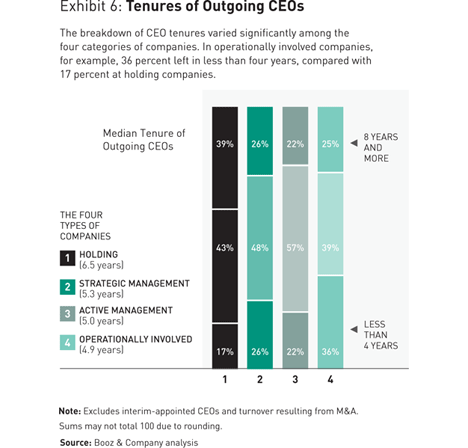
This departure rate at operationally involved companies was particularly high for outsider CEOs — those who were hired from another company. Outsiders are generally more pressured; in all categories except holding companies (in which only one outsider CEO left in 2010, a chief executive who had lasted for a statistically anomalous 17 years), they stayed in office for less time on average than their insider counterparts. Outsiders at Model 4 companies had the shortest tenure of all: on average, only 3.3 years in office. (See Exhibit 7.)
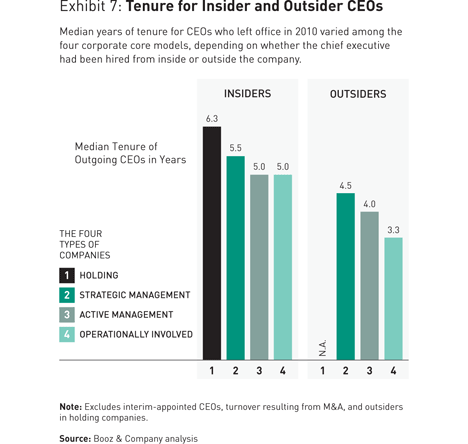
Why was CEO turnover higher in Model 4 companies? It wasn’t because of inexperience: The proportion of Model 4 outgoing CEOs who had prior CEO experience was higher than in any other model group. Nor was it a matter of a lack of coaching or support. The apprentice CEO model is more prevalent at operationally involved companies than at holding companies (38 percent as compared with 32 percent), and Model 4 headquarters organizations are much larger, as a rule. However, CEOs in Model 4 companies face some particular challenges:
1. Operationally involved companies are more likely to be acquired. M&A successions are most common among Model 4 firms (in 2010, they represented 52 percent of non-planned turnover, versus 40 percent at Model 1 companies and 26 percent at Model 2 companies). Because Model 4 companies typically focus on a single industry or business, they are often attractive targets for acquisition. And although Model 1 and 2 companies may engage in M&A activity more frequently, they typically buy and sell subsidiary units, not whole companies, so the CEO position is usually not affected.
2. Operationally involved CEOs more often succumb to board and power struggles. These struggles accounted for 57 percent of the forced (non-planned and non-M&A) turnover at Model 4 companies in 2010. By contrast, in Model 2 companies, poor financial or managerial performance was the main driver of forced succession. (See Exhibit 8.) In a single-line or closely related set of businesses, it is easier for the board to apply strict scrutiny to a CEO’s strategy, and power struggles with other knowledgeable insiders are more likely.
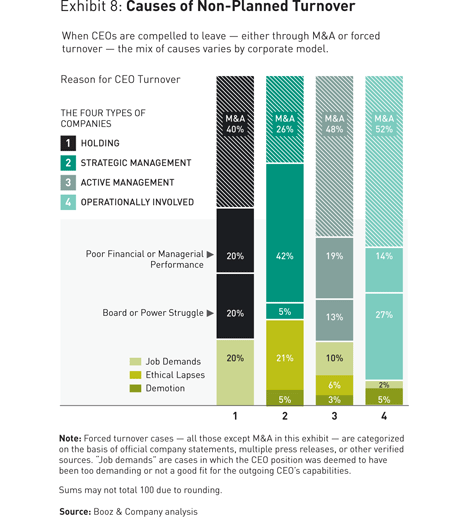
3. Operationally involved and active management CEOs are more likely to also hold the chairman title. This is twice as likely, on average, as it is in the other two models. Overall, only one in 10 CEOs has this dual role, but the more involved the corporate core is in the business operations, the more likely the double role is to appear. (See Exhibit 9.) The correlation between actively engaged corporate cores and “double-hatted” CEO/chairmen is particularly strong in Europe.
At first glance, this correlation seems puzzling. Double-hatted CEOs are subject to immense job demands in any company; they run both the board — which is charged with scrutinizing their strategy — and the business. In Model 3 and Model 4 companies, their roles would be even more demanding. One may surmise that this trend is either an anomaly (in which case we will probably see it diminish in future years) or a sign that some boards still believe that a single leader accountable for the entire company provides the most effective form of governance.
Advice for the New CEO
Few CEOs would interpret these findings as a suggestion to adopt the holding company model. After all, most companies have developed their corporate core structure over time, to match their unique portfolio of businesses and their competitive strategy. No one model is inherently better than another, and it is neither practical nor desirable to move your corporate model away from what the business requires.
However, if you are the CEO in a Model 4 company, you should recognize the especially demanding nature of this job. It requires hands-on management and greater accountability, and your exposure to disruption is therefore higher. More than one-third of operationally involved CEOs are replaced within four years; indeed, your role may involve quietly building value to become an acquisition target. Model 4 boards tend to be more informed and engaged in monitoring strategy, and the competition for the chief executive position can be more intense — there are often several candidates well versed in the business vying for the position. These challenges will be all the more formidable if you are hired from outside.
Of course, CEOs at companies with other core models also face great pressures. As we noted earlier, planned-succession tenures, overall, have dropped from 10 years to seven since 2000. In a large company, seven years can be a very short time to set an agenda and execute it. Nonetheless, as an incoming CEO, you should adjust your expectations accordingly, and be prepared to demonstrate early wins in the first few years to solidify your position.
If you are a board member or senior executive in search of a long-term CEO, you face a different, but equally immense, challenge. As they develop through their careers, very few candidates will automatically receive the breadth of general management experience and functional expertise needed to oversee a large global enterprise. In a Model 1 company, up-and-coming executives have the early opportunity to run a P&L, but they may not get a broader sense of the whole portfolio or develop strong functional skills. By contrast, in a typical Model 4 company, there will be a cadre of executives with high levels of functional expertise and strong industry knowledge, but their general management experience may be less robust.
It is the responsibility of sitting CEOs and boards to plan for succession by building a bench of well-rounded candidates that transcends any management development limits in their corporate core model. Model 1 and 2 companies need to help their general managers cultivate functional and portfolio management skills. Model 3 and 4 companies need to give their functional specialists general management experience. Thoughtful executives planning their own careers would do well to take on roles that help fill the gaps.
If you are a new CEO, awareness of your corporate core model can help you establish a better position. For example, a new CEO coming from the outside into a company with an active management model can lay the groundwork for success early by appointing well-regarded insiders to one or two top jobs, to engage the organization more effectively. Similarly, in last year’s study, we highlighted the growing importance of regarding the board of directors as a strategic partner. This advice is crucial if you are the CEO of an operationally involved company, especially given the fact that skirmishes with the board account for most CEO dismissals in those companies. The more effective your engagement is with the board, the more likely your succession is to be a planned one.
In general, chief executives need to adapt their personal management style to the company’s corporate core model. This may be particularly challenging if you are a new CEO in a Model 1 or Model 2 company. More likely than not, you were an operationally involved business unit head before taking the top job. Now, you will have to deliberately learn to delegate accountability for running the businesses so you can focus on adding value to the larger organization.
No matter where you sit on the corporate core spectrum, the challenges of being the CEO of a major corporation are considerable and growing, while the window you have to address and overcome those challenges continues to narrow. Never has the job been more exciting…or more daunting. ![]()
A Tipping Point for the Global Economy
by Ivan de Souza and Edward Tse
The changing composition of this year’s sample of the world’s top 2,500 public companies by market capitalization is, in and of itself, a significant portent of a profound shift about to occur in the global economy. The center of gravity among global corporations is moving from mature Western economies to emerging markets. (See Exhibit 3.) The details vary by country and industry, but some general truths broadly apply.
Companies in emerging economies — not only in Brazil, Russia, India, and China (the BRIC countries), but also in the “next 11” countries named by Goldman Sachs: Bangladesh, Egypt, Indonesia, Iran, Mexico, Nigeria, Pakistan, the Philippines, South Korea, Turkey, and Vietnam — are in hyper-growth mode. They are on the early and steep side of what we at Booz & Company call the arc of growth: the natural evolutionary cycle of any country or region as it enters the industrialized economy. Meanwhile, the mature economies of North America and western Europe are confronting challenges in generating further growth — challenges that have only been exacerbated by the economic turmoil of the past few years. The global recession has exaggerated the dichotomy between rapidly growing BRIC and next 11 countries on the one hand, and those in the Organisation for Economic Co-operation and Development on the other.
Furthermore, companies based in these emerging economies have far greater access to capital markets than they did even five years ago. Investors now perceive these economies more favorably, and the senior management of these companies have become more worldly in their outlook. Companies can now capitalize through IPOs, finance additional activity, and fund acquisitions in their own geographies as well as abroad (including in North America and western Europe).
Finally, companies in the world’s emerging economies enjoy significant resource advantages. It’s little wonder that demographically advantaged countries, such as India and China, and countries endowed with natural resources, such as Russia and Brazil, have seized the lion’s share of the growth in global GDP over the past several years.
Although these general truths apply to all emerging economies, China’s story has some unique elements. First, despite being publicly listed, the largest Chinese companies in our sample are still controlled by the state, which retains a substantial ownership stake. (Of the 232 Chinese companies on our global list of 2,500, the state owns all of the top 10.) The Communist Party appoints the chairman and the CEO of these enterprises from a roster it maintains of industry experts. (That said, the Chinese government has installed Western-style boards of directors in the top government-owned enterprises in China, and these boards exercise a good deal of authority.) Finally, given the high degree of government oversight, companies in China often enjoy distinct positional advantages, at least domestically, and M&A activity is rare. These factors all help explain why China’s CEO turnover is so low compared with that of other countries. (See Exhibit 4.)
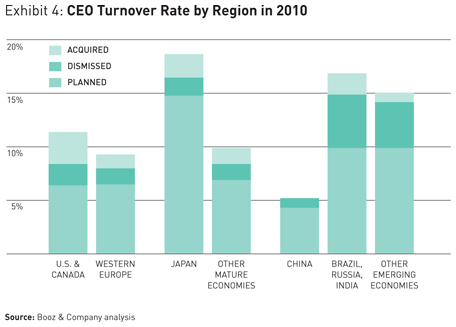
In the coming years, we should see Chinese companies and their emerging-market peers open up more and more to the rest of the world, in terms of both mind-set and footprint. Chinese business leaders, by necessity, will maintain a more international outlook; this will undoubtedly have an impact on CEO succession in years to come.
- Ivan de Souza is a senior partner with Booz & Company based in Sao Paolo and is managing director of the firm’s global markets business.
- Edward Tse is a senior partner with Booz & Company based in Shanghai and Hong Kong, and is the firm’s chairman for Greater China.
Methodology
The 2010 CEO Succession study identified the world’s 2,500 largest public companies as measured by their market capitalization (per Bloomberg) on January 1, 2010. Booz & Company research team members based in India, China, Romania, Chile, the United Arab Emirates, Italy, France, and the United States then identified the companies among the top 2,500 that had experienced a chief executive succession event and cross-checked data using a wide variety of printed and electronic sources in multiple languages. For a listing of companies that had been acquired or merged in 2010, we again used Bloomberg. In considering relative market capitalization, we did not adjust for currency exchange rate fluctuations, which have an insignificant effect over time because they quickly adjust to market reality. (We also note that China’s currency is pegged to the U.S. dollar.)
We investigated each company that appeared to have changed its CEO to confirm that a succession event occurred in 2010, and for the 291 confirmed companies, we compiled demographic, career, and governance structure details on both outgoing and incoming CEOs (as well as any interim chief executives), including age, tenure, title, career path, prior experience, education, and chairmanship, among others. In the analysis of CEO succession by tenure of outgoing CEO (Exhibit 6), insider/outsider status (Exhibit 7), and CEO background (Exhibit 9), we excluded turnover events involving interim-appointed CEOs, and those resulting from mergers and acquisitions.
We accepted company-provided information for all data elements except for the reason for the succession. For that, we consulted outside press reports and other independent sources.
Total shareholder return data for a CEO’s tenure was sourced from Bloomberg and includes reinvestment of dividends, if any. Company return data was then regionally market-adjusted (against the return of the local regional index over the same time period) and annualized.
Corporate core classification of each of the 291 companies experiencing a succession event in 2010 was based on multiple factors (e.g., number and diversity of business units, degree of shared activities, number and percentage of top-line versus functional managers), as well as Booz & Company expertise on industry and geographic operating models.
To distinguish between mature and emerging economies, we followed the United Nations’ Human Development Index 2010 ranking, which classifies countries with a score above 0.788 as “very high.” Mature economies include South Korea, Australia, the Czech Republic, Poland, and Hong Kong; emerging economies include Turkey, Saudi Arabia, Mexico, and South Africa. For the purposes of this study, Hong Kong and Macau are classified as separate from China.
Reprint No. 11207
Author profiles:
- Ken Favaro is a senior partner with Booz & Company based in New York. He leads the firm’s work in enterprise strategy and finance.
- Per-Ola Karlsson is a senior partner with Booz & Company based in Stockholm. He is managing director of the firm’s European business.
- Gary L. Neilson is a senior partner with Booz & Company based in Chicago. He focuses on operating models and organizational transformation and is a leader of the firm’s work on organizational DNA.
- Also contributing to this article were Booz & Company Senior Associates Alexis Bour and Kenji Chikada and s+b contributing writer Tara A. Owen.



